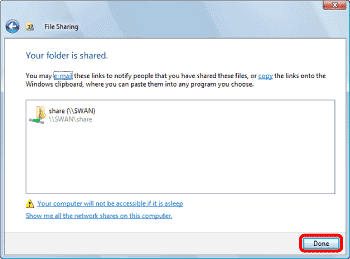Setting Shared Folder (Windows Vista) (MF9200 Series)
| Article ID: ART108075 | | | Date published: 05/11/2015 | | | Date last updated: 08/15/2015 |
Description
Solution
Setting Shared Folder (Windows Vista)
Shared Folder without Access Control
This is useful when you want to share files with other users over a network without any restrictions.
Users can access these folders from any computer on the network without having to enter a user name and password.
Follow the procedure below to set up the shared folder without access control.
In Windows Vista, you can use the special folder named "Public folder," which allows files to be shared with other users on the same network. Using the Public folder, you can set up a shared folder without access control.
note:
By default, the Public folder is created in the [Users] folder, on the drive (e.g. C drive) Windows Vista is installed on.
Example: \Public\share
Sharing the Public folder
1. On the [Start] menu, select [Control Panel] to open [Control Panel] window.
2. Click [Set up file sharing] to open the [Network and Sharing Center] window.

3. In the [Network and Sharing Center] window, click the downwards arrow next to [Public folder sharing].

4. Check [Turn on sharing so anyone with network access can open, change, and create files], and then click [Apply].

note:
- Do not select [Turn on sharing so anyone with network access can open files]. Otherwise, you will not be able to store a document scanned with this machine in a shared folder.
- If the [User Account Control] dialog box appears, click [Continue].
5. Click the downwards arrow next to [Password protected sharing].

6. Click [Turn off password protected sharing], and then click [Apply].
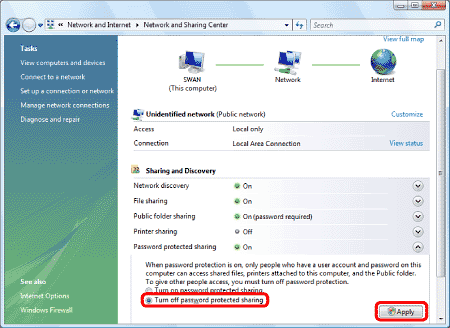
note:
If the [User Account Control] dialog box appears, click [Continue].
Creating a folder to store a file
You can store a file in the first level of the Public folder. This section describes the procedure for creating a new folder in which to store a file in the Public folder.
1. Display the Public folder in Windows Explorer, etc.
2. Create a new folder in the Public folder.
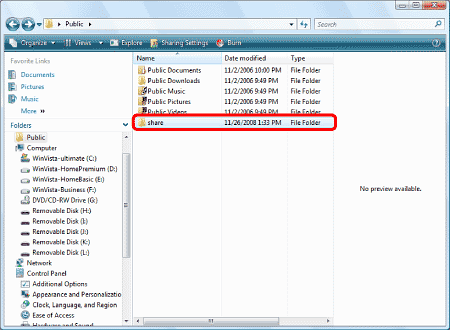
note:
It is recommended that you write down the folder name you created here.
Shared Folder with Access Control
This is useful when you want to limit access to certain users.
To access a shared folder of this type, users must have account information (user names and passwords) for the shared folder. If they do not know their account information, they cannot access that shared folder.
Follow the procedure below to access a shared folder with access control.
Creating a User Account for Accessing a Shared Folder
You need to create user accounts for users who access the shared folder in advance. This section describes the procedure for creating a new account on your computer.
note:
Even if you do not create a new account by following the procedures below, you can add a pre-registered account for users who are permitted to access the shared folder. In such case, you need to create a password if one has not been set for the pre-registered account. Once the password is created, the user is prompted to type it when he/she logs on to a computer.
1. On the [Start] menu, select [Control Panel] to open [Control Panel] window.
2. Click [Add or remove user accounts].

note:
If the [User Account Control] dialog box appears, click [Continue].
3. In the [Manage Accounts] dialog box, click [Create a new account].

4. In the [Create New Account] dialog box, enter the user name, check [Standard user], and then click [Create Account].

note:
- The user name must be up to 20 alphanumeric characters long.
- It is recommended that you write down the user name you created here.
5. Click the user name created in the [Manage Accounts], and then click [Create a password].

6. In the [Create Password] dialog box, type the password in two boxes, and then click [Create password].
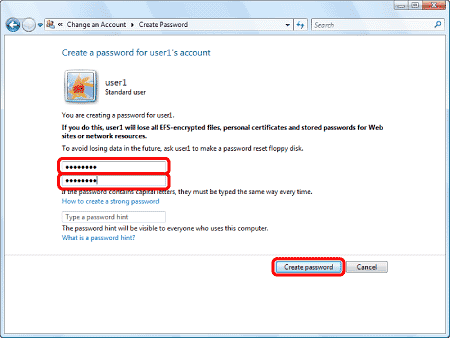
note:
- The password must be up to 14 alphanumeric characters long.
- It is recommended that you write down the password you created here.
7. Close the [Change an Account] dialog box.
Setting a Shared Folder and Access Permissions
Once you create the account on your computer, create a shared folder. Add the created account to the shared folder as a user who is permitted to access that folder. Set the permission which allows the user to access the folders as well.
note:
If "Access permissions" are granted to users who are registered to computers, they are authorized to operate folders and files.
There are two types of access permissions:
-
Network-level access permission
This is to control users who access to the shared folder over the network.
-
Local-level access permission
This is to control users who access folders by logging on to their computers.The local-level access permission can be set only when the drive in which folders are located is formatted in NTFS.
The [File Sharing] dialog box is used to set up the access permissions. The network-level and local-level access permissions for a user will be set simultaneously when you select a permission level in the [File Sharing] dialog box.
1. Create a folder in any drive.
It is recommended to create the folder in a place where users can find it easily, such as the first level in C drive.
Ex) C:\share
note:
It is recommended that you write down the folder name you created here.
2. Right-click the created folder.
3. Select [Share...] to open the [File Sharing] dialog box.
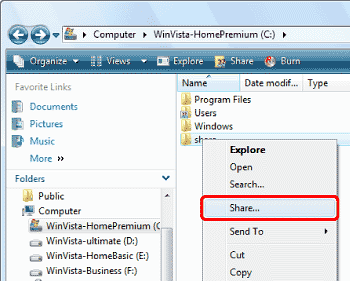
4. Click [  ] on the left side of [Add...], and then select the user.
] on the left side of [Add...], and then select the user.
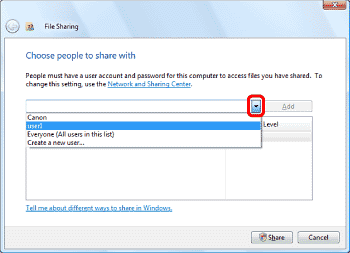
5. Click [Add].
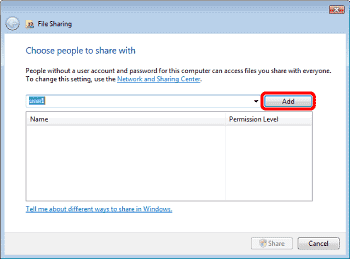
6. Select the added user. Select the [Contributor] or [Co-owner] check box. Click [Share].
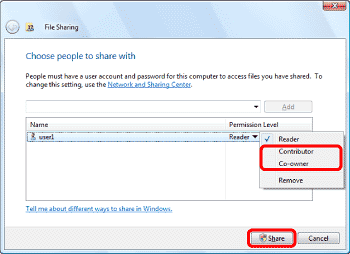
note:
- If the [User Account Control] dialog box appears, click [Continue].
-
Access permissions in Windows Vista
- Reader: A reader can only view shared files.
- Contributor: A contributor can create, alter and delete shared files, but not alter access permissions.
- Co-owner: A co-owner can perform all file operations including creating, altering, deleting shared files and altering access permissions.
7. Click [Done] to close the [File Sharing] dialog box.
